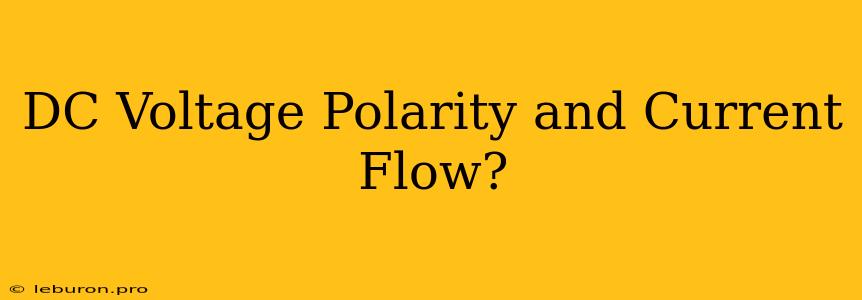Understanding DC voltage polarity and current flow is fundamental to comprehending electrical circuits. While the terms "voltage" and "current" are often used interchangeably, they represent distinct aspects of electrical energy. Voltage refers to the electrical potential difference between two points, analogous to pressure in a water system. Current describes the flow of electrical charges, akin to the water itself moving through pipes. Polarity dictates the direction of this flow, crucial for ensuring proper operation in DC circuits. This article delves into the intricacies of DC voltage polarity and current flow, providing a clear understanding of their significance in electrical applications.
DC Voltage Polarity: The Direction of Potential Difference
DC voltage is characterized by a constant polarity, meaning the electrical potential difference between two points remains consistent over time. This consistent polarity is essential for defining the direction of current flow in a circuit.
Conventionally, the positive (+) terminal of a DC voltage source is considered to have a higher electrical potential than the negative (-) terminal. This difference in potential drives the flow of electrical charges, creating current.
Think of a battery as a prime example of a DC voltage source. The positive terminal represents the "high" potential, while the negative terminal signifies the "low" potential. Electrons, the negatively charged particles responsible for current flow, are naturally drawn towards the positive terminal. This movement of electrons from the negative to the positive terminal defines the direction of current flow.
Understanding the Terminology:
- Voltage (V): The measure of electrical potential difference between two points. It is measured in Volts (V).
- Current (I): The flow of electrical charges, measured in Amperes (A).
- Polarity: The direction of voltage, indicated by the positive (+) and negative (-) signs.
- Direct Current (DC): Current that flows in a single direction, as opposed to Alternating Current (AC) which changes direction periodically.
Current Flow: The Movement of Electrical Charges
Current flow in a DC circuit is driven by the voltage difference between the positive and negative terminals of the voltage source. Electrons, being negatively charged, are attracted to the positive terminal. This attraction causes them to move from the negative terminal, through the circuit, and towards the positive terminal.
Conventionally, current flow is defined as the direction of positive charge movement. However, electrons carry a negative charge. This seemingly contradictory convention was established before the discovery of electrons and remains in use today.
The Significance of Current Flow Direction:
- Component Operation: Most electronic components are designed to operate with specific polarity and current flow. Reversing the polarity can lead to damage or malfunction.
- Circuit Functionality: The correct current flow direction is crucial for achieving the desired functionality of a circuit.
- Safety: Incorrect polarity can lead to short circuits or other safety hazards.
Visualizing DC Voltage Polarity and Current Flow
Imagine a simple circuit containing a battery, a light bulb, and connecting wires. The battery is the source of DC voltage, with a positive (+) terminal and a negative (-) terminal.
- Voltage: The battery creates a potential difference between its terminals. This difference is represented by the voltage value.
- Current Flow: The electrons move from the negative terminal of the battery, through the wires, through the light bulb, and back to the positive terminal of the battery. This flow of electrons constitutes the current.
The direction of current flow is conventionally depicted as the movement of positive charges, from the positive terminal of the battery, through the circuit, and back to the negative terminal. This convention is important for analyzing and understanding circuit behavior.
Practical Applications of DC Voltage Polarity and Current Flow
Understanding DC voltage polarity and current flow is essential in many practical applications, including:
- Electronic Circuits: Correctly identifying and applying DC voltage polarity ensures components operate properly and circuits function as intended.
- Battery Systems: Proper connection of battery terminals is crucial for safe and efficient charging and discharging.
- Power Supplies: Understanding DC voltage polarity and current flow allows for proper selection and connection of power supplies for electronic devices.
- Motors and Actuators: DC motors and actuators rely on specific voltage polarities to control direction of rotation or movement.
- LED Lighting: LEDs require precise polarity for illumination, and reversing polarity can damage them.
Conclusion
DC voltage polarity and current flow are fundamental concepts in electrical circuits. Understanding these concepts is essential for properly designing, operating, and troubleshooting DC circuits. By grasping the principles of voltage, current, and polarity, individuals can ensure safe and effective utilization of DC power in a wide range of applications.
